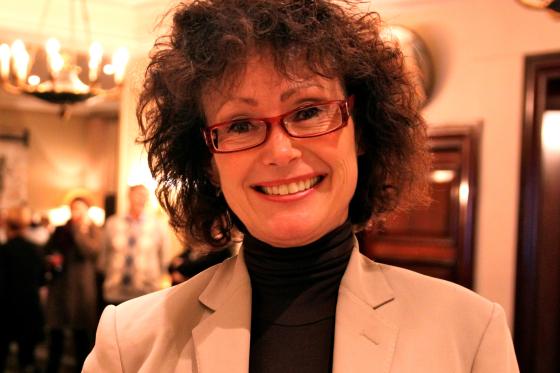"Gender differences in leadership are a myth"
According to a new doctoral project, there is no difference in the leadership styles of men and women. In groups comprised of both genders, an androgynous leadership style was found to be the best for creating a climate for innovation.
“Leadership style can be independent from biological gender. Men and women don’t have different styles of leadership. We should be cautious when working with gender balance and gender equality in organizations,” says Anne Grethe Solberg.
Solberg recently completed her doctoral degree in sociology with a thesis on gender and innovation management. In her study, she shows that women’s and men’s leadership styles are only marginally different.
The study is based on extensive questionnaires given to 917 top- and mid-level managers in private business in Norway; 34 percent of these were women. The questionnaires measure the managers’ perceptions of their own gender role identification, leadership style and innovation climate.
Masculine minority
An almost equal number of men and women fall into four categories of leadership style: masculine, feminine, androgynous (both masculine and feminine) and undifferentiated (neither masculine nor feminine). These leadership styles are used in the Bem Sex Role Inventory (BSRI), a standardized instrument for measuring gender role perceptions.
There are nearly as many male managers with a feminine leadership style as there are female managers with a masculine leadership style, and an equal number of female and male managers have an androgynous leadership style.
The so-called masculine leadership style – which includes both women and men – comprises only 30 percent of the sample.
“It’s more of a myth than a documented fact that leadership is specifically linked to the masculine. The dominance of the masculine male’s leadership style does not correspond with the actual situation in my sample,” explains Solberg.
Androgynous leadership style best
According to Solberg’s study, androgynous managers report having the best innovation climate in their groups. A good innovation climate entails setting clear, common objectives and visions, creating a sense of security for participants in the work group, facilitating the development of ideas and creativity, and keeping the group’s work on task. The androgynous managers are in the minority in the sample; approximately 22 percent of the managers fall into this category. Solberg finds about the same number of male and female managers with an androgynous leadership style.
“Kristin Skogen Lund, Director General of the Confederation of Norwegian Enterprise, fits the description of an androgynous leadership style perfectly. She lets others carry the ball and helps them to develop their talents and skills, while at the same time she doesn’t put herself first,” Solberg believes.
“Effective managers are not authoritarian and domineering. They are facilitators who dare to be objective.”
“Androgynous managers have less of a need than feminine and masculine managers to put people into boxes. They have a more coaching-oriented style, and are empathetic, understanding, democratic and participant oriented. They are concerned about change and are the engine that propels the discussion forward,” says Solberg.
Managers who are strictly masculine or feminine create less open groups, resulting in a poorer climate for innovation. Masculine and feminine managers are more prone to categorizing other workers and ascribing certain characteristics to women and men, which more often creates an environment for discrimination, according to the researcher.
The efficiency myth
Solberg’s results challenge the notion that gender diversity in organizations leads to greater efficiency, creativity and profitability, one of the main arguments on which Norway’s well-known gender quota for public company boards is based.
“This doesn’t happen just because a board or a group is comprised of both women and men,” states Solberg.
“In order to benefit from the alleged gender differences, we need to develop a new type of communications culture that is inclusive for heterogeneous groups, taking into account that people are different – regardless of biological gender. It’s important to foster this difference.”
New generations
In her doctoral thesis, Solberg speculates as to whether authoritarian masculine leadership is no longer what is needed to achieve the results sought today. Globalization has intensified the pressure and demands for innovation and change, with a corresponding focus on workers and knowledge. According to her study, it is the androgynous leadership style that is needed to meet these demands.
In addition, Solberg believes that managers who grow up with a high degree of gender equality in modern-day Norway are freer to make choices regarding gender roles than previous generations.
“The average age of the sample is 45, so the managers who grew up in the 1960s, 70s and 80s may have been less impacted by stereotypical role models than previous generations. Their families have probably had a relatively good financial situation because their mothers worked outside the home, and they may have had fathers with caregiving responsibilities at home,” Solberg writes.
However, Solberg’s study does confirm some stereotypical findings: What distinguishes men from women the most in her sample are issues related to their attitude towards gender equality. The male managers in the sample do not have such strong opinions about gender equality as the female managers do.
Cracks in the glass ceiling
In 1995, Solberg wrote a book on the glass ceiling that prevents women from reaching the top of the management hierarchy in society. Prior to that, she wrote her thesis at second-degree level in sociology on the same topic. Not to mention her systematic work over several decades as a head hunter and consultant focusing on the recruitment of women to high-level management positions, and in particular exposing attitudes about gender. So it was an enormous surprise when Solberg did not find support for the so-called glass ceiling in her doctoral research material.
“We still see differences in men’s and women’s salaries, and we see statistical differences between the number of men and women in management. But what happens within the organization’s four walls might express itself differently than it used to. The theory of the glass ceiling is 20-30 years old. It has become a theory surrounded by myths about the unconscious and invisible effects of gender. We must dare to look at gender and leadership through different glasses. In any case, I don’t see any glass ceiling in my data,” says Solberg.
“The individuals who have broken through the glass ceiling represent an equal number of androgynous, feminine and masculine gender role identities.”

Acclaim for her consulting work
By the same token, it is important to Solberg that not everything focuses on theory and research.
“We cannot get further without practice,” the consultant states.
For 15 years she has worked as a consultant in companies such as the ISCO Group, Capgemini and Ernst & Young, with recruitment of women as her speciality. In 2003 she took the plunge and launched her own company, Gender Consulting. This year she was the first woman to receive the industry’s Consultant of the Year Award, and she took second place in the Constantinus International Award in the US, which was presented for the second consecutive year by the International Council of Management Consulting Institutes.
After receiving the international award, people from around the world have contacted Solberg, wanting to hear more about her programme. Solberg thinks this is interesting, and she is curious about whether her methods are transferrable to China or Japan, for example, where they have other types of organizational cultures.
Breaking the code
After many years in the industry, Solberg has developed a comprehensive programme designed to change the gender balance in companies and organizations. Put simply, the programme helps women to break the codes that allow them to move up in the company, while the management must work with changing the culture by creating conditions so that the employees’ entire repertoire is utilized.
“When you come into an organization, you have to think: ’If I can’t beat them, just join them.’ You must break the codes! When you’re finished with my programme, you will be a natural part of the shortlist when new managers are recruited,” says Solberg.
She believes the codes are not dependent on gender. The same codes apply to both women and men.
“Take the codes for becoming a professor, for example. You might need to have a post-doc from abroad, maybe you need to show high productivity, commitment and specialization, and you must dare to be selective in your choice of focus. It’s more important to tell female academics or doctoral students about these codes than to create a framework so they can both have children and be competent academics. Let the women themselves take responsibility for deciding how they will perform their mothering role together with the father.”
Family life not the cause
Solberg emphasizes that new questions, new measures and new explanations are needed for working with gender and management issues. Also, when attempting to explain the causes of gender imbalance, she would like to see family life taken out of the equation.
“A great deal of gender and management research focuses on the reproductive sphere. The question ‘But how do you manage to have a family life then?’ is asked a lot. I don’t have a need to link what prevents women from taking management positions with how they organize their families. In any case, it’s more exciting to look at what happens internally in the family,” says Solberg.
“By now I’ve been doing this for many years with career-oriented women and men. What I see is that many men and women live in two-career families with children and they make things work. And it doesn’t cost the women more than the men. Just read Knausgård, where we see that being a dad and the father role is not very different from the mother role.”
Difficult ladies
Although women must break the codes, an effort both to change the management culture and to ensure good recruitment practices is also needed.
“It’s not possible for a dedicated gender equality adviser to go out and change an entire culture on her/his own,” says Solberg, who believes that public institutions have become more inflexible in their view of gender equality than the private sector has. They are good at counting, but not as good at working in a targeted manner for cultural change and innovation.
“In my job I saw that the processes that led to a woman or man getting hired were different.”
Besides the fact that she had to go many rounds with employees in the company to get them to accept a female manager, she also found it was difficult to ask women to take on a management position.
“It took more time to recruit women. They were more sceptical about changing jobs. They worried about what their family and friends would say, and they asked a lot of detailed questions. The men would say, ‘If you have time today, I’ll stop by during the break’.”
New times
Now she has a burning desire to study employees’ perspectives of managers. She also has plans to write books – one based on her doctoral thesis, a “how to” book on how to work with gender balance in organizations based on her many years of practical work experience, and a book on self-management which also discusses how to break codes.
“The most exciting aspect of my thesis is my findings about the glass ceiling,” says the sociologist.
“We must think along new lines and find other models for studying organizations. I don’t have the theories and models yet for discovering what this actually is. But I’m willing to throw traditional understandings of gender overboard in order to explore the significance of my findings in other ways.”
Translated by Connie Stultz.
Anne Grethe Solberg owns and operates the consulting firm Gender Consulting. She recently defended her doctoral thesis Et kjønnsperspektiv på innovasjonsledelse (“A Gender Perspective on Innovation Management”) at the Department of Sociology and Human Geography at the University of Oslo.
